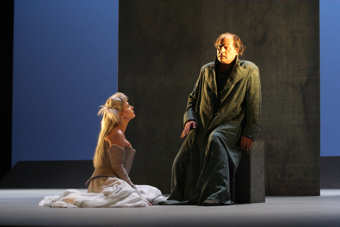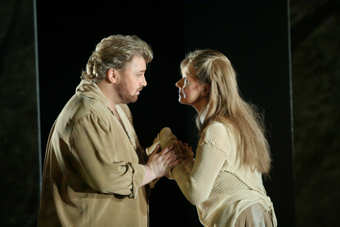|
|
|

Editorial
Board
London Editor:
(London UK)
Melanie
Eskenazi
Regional Editor:
(UK regions and Worldwide)
Bill
Kenny
Webmaster:
Bill
Kenny
Music Web Webmaster:
Len
Mullenger



|
MusicWeb is a
subscription-free site
Clicking Google adverts on our pages helps us keep it that way
Seen
and Heard International Opera Review
Richard Wagner, Die Walküre:
Soloists and orchestra of L'Opéra de
Marseille (new production) Marseille,
France. 23.5.2007 (MM)

Wagner's nine Valkyries landed noisily
on the stage in Marseille (5/16/07)
just six weeks before this second
instalment of Wagner's tetralogy hit
another stage thirty kilometers up the
road at the Aix Festival. This
unpretentious Marseille event has set
the bar fairly high for an inevitable
Marseille/Aix Walküre
competition.
The Marseille Walküre is
apparently the only survivor of a
complete Marseille Ring which
back in the 1990's got as far as a
Siegfried before community poverty
precluded such excess. Further
intermission intelligence suggested
that the thwarted Ring was a
mise- en-éspace (staged with
costumes and lights, no scenery), and
that the current version was a
resurrection of its original 1996
staging, though an infusion of money
allowed the addition of scenery.
Happily it is not the resumption of
another larger Ring project
that would serve only to usurp too
much of Marseille's small
season.
In this production the obvious detail in the staging was striking.
Perhaps originally lacking the scenographic means to display a
concept, led stage director Charles
Roubaud to illustrate Wagner's text
with literal actions, abstracted only
inasmuch as they were acted without
props, i.e. sword, swords, spears or
staves and with the pivotal Hunding /Siegmund
duel taking place off stage. The
resulting intimacy of this approach
rendered Wagner's characters human
rather than godlike, prosaic rather
than legendary.
The Marseille stage provides an
intimacy with which is quite unusual
for a proscenium theater, and also an
even rarer acoustic that permits every
word and nuance of voice to sail over
its bright and present pit. It is a
fine theater and Marseille's
excellent cast took advantage of these
attributes to play Wagner's drama to
the hilt, vocally and
histrionically. Albert Dohmen,
Wotan, used his black low notes and
bright upper register fully, sometimes
falling into a sort of
sprechtstimme to effectively color
the extended Wotan monologues, making
them vivid enactments of the
conflicted state of this vulnerable
god. Simply cloaked without hat and
eye patch, Dohmen's presence was huge,
his ample physique underlining Wotan's
human vulnerability rather than his
heroic lineage.

Janice Baird's Brünnhilde was
vocally and physically heroic, her
voice rising easily above her
eight sisters. Her palpable
warrior energy gave way to a quite
visible vulnerability when subjected
to Wotan's wrath, acted certainly, but
intensified by a discernable sense of
her perhaps early middle age. This
Brünnhilde was a woman not a
girl, making the human stakes in this
scene keenly felt.
The nine, mature voiced Valkyrie
sisters, unarmed and shieldless, were
very effectively costumed by Katia
Duflot in filmy skirts and constructed
tops suggesting armor while exposing
ample décolletage. This
ensemble tore the stage up
vocally in its justifiably famous
scene, here sung by real, big voices,
not young-artist program apprentices.
The Siegmund of Torsten Kerland was
beautifully sung, his ample physique
revealing both his character' naiveté
and his wolf-man origins. The
Sieglinde of Gabriele Fontana was
equally impressive, her somewhat
excessive ardor making her a
believable victim. These were both
appropriately sized, healthy younger
voices that gave vibrant life to
Walküre's stand alone first act
music. Convincing presences both
vocally and histrionically were Artur
Korn's Hunding of and the Fricka
of Sally Burgess, whose costume, an
abstraction of mythical forms, perhaps
would have been just right in the
original mise-en-éspace.
Richard Wagner fancied himself a
philosopher, and perhaps in the
Ring, some sort of
theologian. The simplicity of his
ideas, their grandness, and their
basic appeal (the power of love, the
evil of money) are integral to the
Wagnerian poetic. This opera's story
of incest and adultery, of marital and
family squabbles taken literally,
without Wagner's philosophical frame,
is hard to fit to the idealized Wagner
musical continuum. It was Richard
Strauss who knew how to deal with such
subject matter.
The setting of the Marseille
Walküre could have provided the
needed conceptual framework for the
production but did not. Credited in
the program to Michel Hamon as "dispositif
scénique" or scenic plan rather then
as "decors", the stage picture was a
neutral dark space, sometimes fully
covered with a transparent screen
(scrim). At other times, smaller
oblong screens descended, and other
very narrow oblong shapes with an
angular cut at the bottom (get it?)
were also present. Images, abstract
shapes generally, were projected onto
these various screen forms to suggest
both places (Hunding's hut) and
physical objects (cups, swords,
spears) whose uses were mimed by the
singers.
The best moments of this
Walküre occurred when the "dispositif
scénique" was forgotten for a few
minutes, the stage cleared of
apparatus and image, and the original
mise-en-éspace merged into the
musical continuum through the use of
lights. Lighting designer Marc
Delamézière did indeed provide some
fine, musically motivated stage
pictures effected by sculptural
side lighting, and his use of bright
light, white light, shadow and
darkness.
Video segments, realized by Gilles
Papain, were projected onto these
various screens at the obvious moments
in the story (the ride of the
Valkyries, the ring of fire) but also
at inopportune moments (a center
stage, ten meters tall, blinking
Brunnhilde eavesdropping on Siegmund
and Sieglinde huddled in a corner).
Certainly not inexpensive to realize,
the flatly projected elements of this
production looked like expedient cheap
solutions. Worse, they deprived the
stage of dimensionality, belying the
Wagnerian poetic, the over-riding
attribute of which is its sense of
philosophic and emotional depth. At
once the scenic elements were
simultaneously not enough, too much,
inappropriate, unmusical, and rarely
but sometimes effective.
All this contributed to a musicality
that was finely detailed though
sometimes tedious. How much of the
tedium should be attributed to the
conductor Friedrich Pleyer is hard to
know as the staging was so out
of balance with Wagner and the pit.
While the big orchestral moments were
sufficiently grand, maestro Pleyer's
Walküre finally never did catch
fire though he gave, like all the
stage players and the orchestra, a
fine and committed performance. On
then, to Aix.
Michael
Milenski
Pictures
©
Christian Dresse
Back
to the Top
Back to the Index Page
|
Seen and Heard, one of the longest established live
music review web sites on the Internet, publishes original reviews
of recitals, concerts and opera performances from the UK and internationally.
We update often, and sometimes daily, to bring you fast reviews,
each of which offers a breadth of knowledge and attention to performance
detail that is sometimes difficult for readers to find elsewhere.
Seen and Heard
publishes interviews with musicians, musicologists and directors
which feature both established artists and lesser known performers.
We also feature articles on the classical music industry and we
use other arts media to connect between music and culture in its
widest terms.
Seen and Heard
aims to present the best in new criticism from writers with a radical
viewpoint and welcomes contributions from all nations. If you would
like to find out more email Regional
Editor Bill Kenny. |
|
| |
|
Contributors: Marc
Bridle, Martin Anderson, Patrick Burnson, Frank Cadenhead, Colin
Clarke, Paul Conway, Geoff Diggines, Sarah Dunlop, Evan Dickerson
Melanie Eskenazi (London Editor) Robert J Farr, Abigail Frymann,
Göran Forsling, Simon Hewitt-Jones, Bruce Hodges,Tim Hodgkinson,
Martin Hoyle, Bernard Jacobson, Tristan Jakob-Hoff, Ben Killeen,
Bill Kenny (Regional Editor), Ian Lace, John Leeman, Sue Loder,Jean
Martin, Neil McGowan, Bettina Mara, Robin Mitchell-Boyask, Simon
Morgan, Aline Nassif, Anne Ozorio, Ian Pace, John Phillips,
Jim Pritchard, John Quinn, Peter Quantrill, Alex Russell, Paul
Serotsky, Harvey Steiman, Christopher Thomas, Raymond Walker, John Warnaby,
Hans-Theodor Wolhfahrt, Peter Grahame Woolf (Founder & Emeritus
Editor)
|
Site design: Bill Kenny
2004 |

